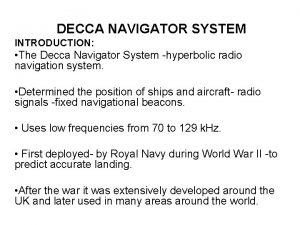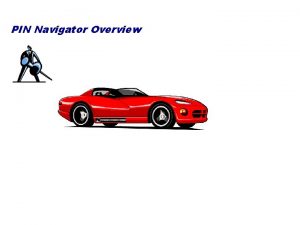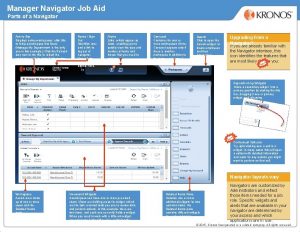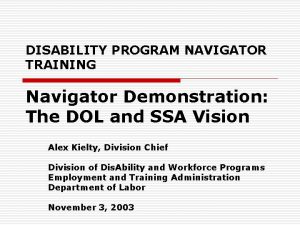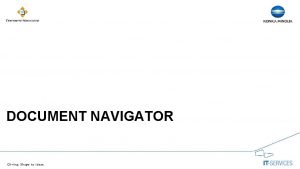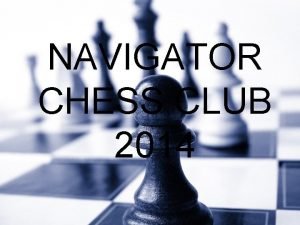DECCA NAVIGATOR SYSTEM INTRODUCTION The Decca Navigator System
















- Slides: 16

DECCA NAVIGATOR SYSTEM INTRODUCTION: • The Decca Navigator System -hyperbolic radio navigation system. • Determined the position of ships and aircraft- radio signals -fixed navigational beacons. • Uses low frequencies from 70 to 129 k. Hz. • First deployed- by Royal Navy during World War II -to predict accurate landing. • After the war it was extensively developed around the UK and later used in many areas around the world.

DECCA'S PROGRESS • Decca's primary use -ship navigation in coastal waters. • offered much better accuracy than the LORAN system. • Decca was replaced, along with Loran and other similar systems, by the GPS during the 1990 s. • The Decca system in Europe was shut down in the spring of 2000, and the last worldwide chain, in Japan, in 2001.

DECCA SYSTEMS Resultant hyperbolic graph. DECCA system

PRINCIPLE OF OPERATIONWORKING • The Decca Navigator System consisted - a number of land-based radio beacons in chains. • Each chain had a master station and three slave stations - Red, Green and Purple. PLACED AT: • the slaves positioned at the - vertices of an equilateral triangle with the master at the centre. • The baseline length - the master-slave distance - 60 – 120 nautical miles (110– 220 km).

WORKING STEPS 1. Each station transmitted a continuous wave signal. 2. comparing the phase difference of the signals- resulted in a set of hyperbolic lines of position - pattern. 3. three Slaves - three patterns. 4. The patterns on- nautical charts -set of hyperbolic lines in the appropriate colour. 5. Receivers identified which hyperbola they were on 6. And a position could be plotted at the intersection of the hyperbola from different patterns - by using the pair with the angle of cut closest to orthogonal as possible.

DIAGRAMATIC REPRESENTATION

Issues faced • If two stations transmit at the same phase-locked frequency then - the difference in phase between the two signals is constant along a hyperbolic path. • but if two stations transmit on the same frequency impossible for the receiver to separate them- so nominal frequency of 1 f was alloted.

• It was phase comparison at this common frequency that resulted in the hyperbolic lines of position. • Hence Decca receivers multiplied the signals received from the Master and each Slave by different values to arrive at a common frequency (least common multiple, LCM) for each Master/Slave pair, as follows:

LANES AND ZONES • The interval between two adjacent hyperbolas on - the signals are in phase was called - lane. • But Early Decca receivers were fitted with three rotating Decometers - indicated the phase difference for each pattern. • Each Decometer drove a second indicator - counted the number of lanes traversed • each 360 degrees of phase difference - one lane traversed. • In this way, assuming the point of departure was known, a more or less distinct location could be

Zone width • Like the lanes were grouped into zones: with 18 green, 24 red or 30 purple lanes in each zone. • This meant that on the baseline- the zone width was the same for all three patterns of a given chain.

MULTIPULSE Multipulse automatic technique- of lane and zone identification. METHODOLOGY: • The nominally continuous wave transmissions -divided into a 20 second cycle. • with each station in turn simultaneously transmitting all 4 Decca frequencies (5 f, 6 f, 8 f and 9 f) - phase-coherent relationship for - 0. 45 seconds each cycle. • This transmission, known as Multipulse. • allowed the receiver to extract the 1 f frequency -so to identify which lane the receiver was in. • As well as transmitting the Decca frequencies of - 5 f, 6 f, 8 f and 9 f, an 8. 2 f signal- known as Orange -was also transmitted. • The beat frequency between the 8. 0 f (Red) and 8. 2 f (Orange) signals allowed a 0. 2 f signal to be derived -corresponds to 5 zones. • Accuracy was maintained deeply here.

RANGE AND ACCURACY • During daylight ranges of around 400 nautical miles (740 km) could be Obtained. • reducing at night to 200 to 250 nautical miles (460 km). • The accuracy depended on: Width of the lanes. Angle of cut of the hyperbolic lines of position Instrumental errors Propagation errors (for example, Skywave) By day these errors could range from a few meters. At night, skywave errors were greater and on receivers- without multipulse capabilities -jumps zones.

DECCOMETER

APPLICATIONS-DELRAC • short for "Decca Long Range Area Cover". • Decca began studying a long-range system -DELRAC by- using much lower frequencies. • FEB 1946 the company - a system with two main stations located at Shannon Airport in Ireland Gander International Airport in Newfoundland. • Together, these stations would provide navigation over - the main great circle route between- London and New York. • A third station in Bermuda would provide general ranging information to measure progress along the main track. • This included features of the General Post Office's POPI system proposing - 28 stations that provided worldwide coverage. • The system was predicted to offer 10 miles (16, 000 m) accuracy at 2, 000 miles (3, 200 km) range 95% of the time.

DECTRA • DECTRA stands for DECCA TRAck. • Dectra was essentially the normal Decca Navigator system with -the modification of several existing transmitter sites. • Dectra operated as a track system -aircraft would navigate by keeping themselves within the signal -defined by a particular Decca lane. • The main advantage of Dectra compared -being proposed for the was that it could be used for both medium-range navigation over land, as well as long-range navigation over the Altlantic • Additionally here, as the Decca system provided an X and Y location, as opposed to the angle-and-range of phase comparision - offering it with their Decca Flight Log moving map

HI-FIX • A more accurate system named Hi-Fix was developed using signalling in the 1. 6 MHz range. • It was used for -precision measurements. • involved with oil-drilling and by the Royal Navy for detailed mapping and surveying of coasts and harbours. • An experimental chain was - installed with coverage of central London and receivers placed in London buses and other vehicles to demonstrate an early vehicle location and tracking system. • Each vehicle would report its location automatically via a conventional VHF two-way radio link, the data added to a voice channel.
 Decca navigation system
Decca navigation system System i navigator
System i navigator Hình ảnh bộ gõ cơ thể búng tay
Hình ảnh bộ gõ cơ thể búng tay Slidetodoc
Slidetodoc Bổ thể
Bổ thể Tỉ lệ cơ thể trẻ em
Tỉ lệ cơ thể trẻ em Gấu đi như thế nào
Gấu đi như thế nào Chụp phim tư thế worms-breton
Chụp phim tư thế worms-breton Hát lên người ơi
Hát lên người ơi Các môn thể thao bắt đầu bằng từ đua
Các môn thể thao bắt đầu bằng từ đua Thế nào là hệ số cao nhất
Thế nào là hệ số cao nhất Các châu lục và đại dương trên thế giới
Các châu lục và đại dương trên thế giới Công thức tính thế năng
Công thức tính thế năng Trời xanh đây là của chúng ta thể thơ
Trời xanh đây là của chúng ta thể thơ Mật thư anh em như thể tay chân
Mật thư anh em như thể tay chân Phép trừ bù
Phép trừ bù Phản ứng thế ankan
Phản ứng thế ankan
